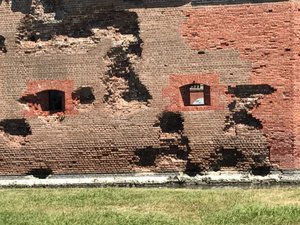Advertisement
Published: April 26th 2017

 IMG_0575
IMG_0575
Remains of the 1862 Shelling. Red Brick was where rebuilding was attemptedFort Pulaski National Monument, Savannah, Georgia
Pulaski was a revolutionary war hero who, as far as I can tell, never saw the fort named in his memory. But his namesake fort played a key role in a way it was never designed for and changed defensive military technology forever.
In the War of 1812, Great Britain handily embarrassed our country by sacking and burning down our capital - hardly an event a country wants to repeat. So our leaders came up with the idea of building 42 forts up and down the Atlantic and Gulf coasts designed to protect our coastal cities from any such future attacks. As is the case today, the effort took more time and much more money than originally thought, but all 42 forts were started in the 1820s. Some were finished, others were not.
We've already visited two of these forts, Fort Pickens (defending Pensacola Harbor, Florida) and Fort Jefferson (defending the lagoons of the Dry Tortugas). Fort Pulaski shares a similar design and construction with those forts. It is a pentagon, like Pickens (Jefferson was a hexagon). And, like both of them, they were built out of massive quantities of bricks. Like

 IMG_0563
IMG_0563
Second Floor View of Cannonsboth of the others, construction was never entirely finished - a third floor never made it on any of them.
Pulaski was built on a Cockspur Island, a barrier island that was the home of two previous wooden forts. The island is in the center of the two channels of the Savannah river and has an excellent command of the entry points into the river. Construction was more than a bit challenging, however, because Georgian barrier islands are really just huge masses of sand. In some places the pilings to support the huge weight of the fort had to be driven down 70 feet before hitting bedrock. With technology available at the time, that wasn't easy to accomplish. They also had the occasional hurricane to deal with, which set them back frequently.
So not only was the third floor never added, but the first two took decades to complete. By 1860, it hadn't even received its full complement of cannons and so only a small number of the casements were armed. (This was also the case at Fort Pickens and Fort Jefferson - the building design was never fully utilized.). Nonetheless, experts declared Fort Pulaski as 'unbreachable' and

 IMG_0560
IMG_0560
The Central Areathe strongest fortification ever built.
In January, 1861, one week after Union troops seized Fort Sumter , 120 miles north in Charleston, the governor of Georgia ordered local militias to seize Fort Pulaski from Union forces, which they did rather easily. Georgia joined the Confederacy a week or so later and gave the fort to the Confederate Army. So the incomplete and not fully armed fort was now part of the Confederacy.
Over the next year, Union forces implemented their strategy of blockading southern port cities and seizing forts when possible. As part of that strategy, the blockade of Savannah (the biggest port city on the Atlantic in the south) was important. Troops were moved first to Hilton Head, S.C, and then on to Tybee Island, right next door to Cockspur and within sight of Fort Pulaski. In April, of 1862, union forces demanded the fort surrender. Col. Charles H. Olmsted, seeing that the union troops were well out of range (1 mile) of known weaponry thought it was basically a bluff and refused.
On April 10, Captain Quincy Gilmore opened fire on Fort Pulaski with 36 large guns, including 10 new, experimental cannons with rifling. Rifles

 IMG_0561
IMG_0561
An original Casementadd a spin to the projectiles which increase their range and accuracy. Over the next 30 hours, they fired over 5000 cannonballs and newer projectiles. The southeastern corner of the fort, pounded by this new artillery, crumbled. Olmstead, fearful that the breach exposed massive quantities of gunpowder to explosion, surrendered. The unpenetrable fort had fallen.
And so had the notion of forts as a defensive strategy. The new technology had dealt a death blow to the entire notion of fort defense. Add the 'iron-clad' ship technology to house these new weapons and you can retire forts forever.
We took the dogs on the trip to Pulaski and started with the ranger-led tour. She was full of information, but was a little too slow for Fleur, who became anxious. So we peeled off and toured the fort by ourselves. After the 1862 debacle, union forces moved the gunpowder to a series of dirt embankments outside the fort called the Demilune (shaped like a half-moon). Now it is a series of tunnels which the we all enjoyed exploring.
There is a 1.5 mile (round trip) hiking trail out to see the lighthouse (post civil war), and the Tybee Island
site where the union guns were stationed. It runs through marsh land which is a key ecological feature of this part of the world. We wanted to take that hike, but Smooch was getting overheated again. (Dogs are great to travel with, but they can constrain what you can do!)
Not a destination site, but if in Savannah, this is definitely a good tour stop to get a unique perspective on military strategy and technology. (17.1.49)
Advertisement
Tot: 0.295s; Tpl: 0.021s; cc: 8; qc: 46; dbt: 0.1337s; 1; m:domysql w:travelblog (10.17.0.13); sld: 1;
; mem: 1.1mb














